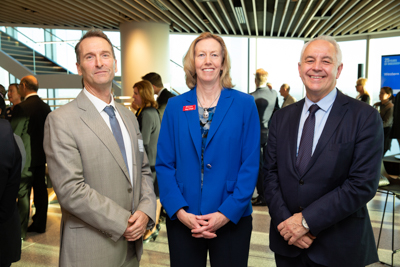An enduring partnership which has contributed to the long-term sustainable use of Western Australia’s North West Shelf was marked with an event at Woodside Energy’s new building in Perth.
The 25-year collaboration between the Australian Institute of Marine Science and Woodside has seen science and industry work side-by-side to explore and conserve the unique marine biodiversity of Western Australia’s tropical marine environment.
WA member of AIMS Council, Ms Jeanette Roberts said the joint work included the longest study of any reef on Australia’s North-West.
“In 1994, AIMS began a long-term monitoring program at Scott Reef,” Ms Roberts said.
“At the time, reefs in the Pilbara and the Kimberley were virtually unexplored and poorly understood.
“The monitoring program and collaboration, which began all those years ago, continues today and is recognised as one of the world’s longest scientific partnerships.”
AIMS CEO, Dr Paul Hardisty, described the scientific knowledge gained from this partnership as being invaluable to the nation, and attributed it to the Institute’s long-term experience in northern Australian waters.
“We now understand the processes that underpin the natural resilience of WA reefs and can describe ecosystem status and trends across scales,” Dr Hardisty said.
He considered the partnership an example of how collaboration between science and industry can work well.
“Science in remote WA can be expensive - to do it properly means our scientists are diving on the reef, doing it safely and effectively from our purpose-built ocean-going research vessels. The involvement of Woodside was one of the key reasons why much of this science has come to fruition.”
Dr Hardisty said AIMS monitoring had found that while some reefs in the north-west were healthy, others were threatened.
“WA reefs face a lot of uncertainty and all of us - government, industry and the community - can work together to improve the health and resilience of coral reefs and protect them from the effects of climate change,” he said
Other distinguished guests at the commemorative event included; Western Australia’s Chief Scientist Professor Peter Klinken AC; AIMS Chairman the Hon Penelope Wensley AC; and Woodside Chief Operating Officer Meg O’Neill, who also recognised the company’s 20-year partnership with the Western Australian Museum.
“We have discovered much more about WA’s treasured offshore reefs and how we can continue to manage the potential impacts from our activities,” Ms O’Neill said.
From the partnership she said Woodside has a greater understanding of the Dampier Archipelago, and its marine inhabitants – some residing 800m below the surface.
“Our partnerships with the WA Museum and AIMS have laid a good foundation for providing a long-term knowledge base that underpins our environmental understanding and informs our approvals and impact assessments,” Ms O’Neill said.
WA Museum’s CEO, Alec Coles OBE, said the Museum’s 20-year partnership with Woodside Energy had brought together some of the world’s most esteemed marine biologists and taxonomists, whose collaboration had achieved remarkable outcomes and achievements.
With an eye on the future he said: “the partnership has added value by translating knowledge into information for everyone and has trained the next generation of skilled scientists”.


